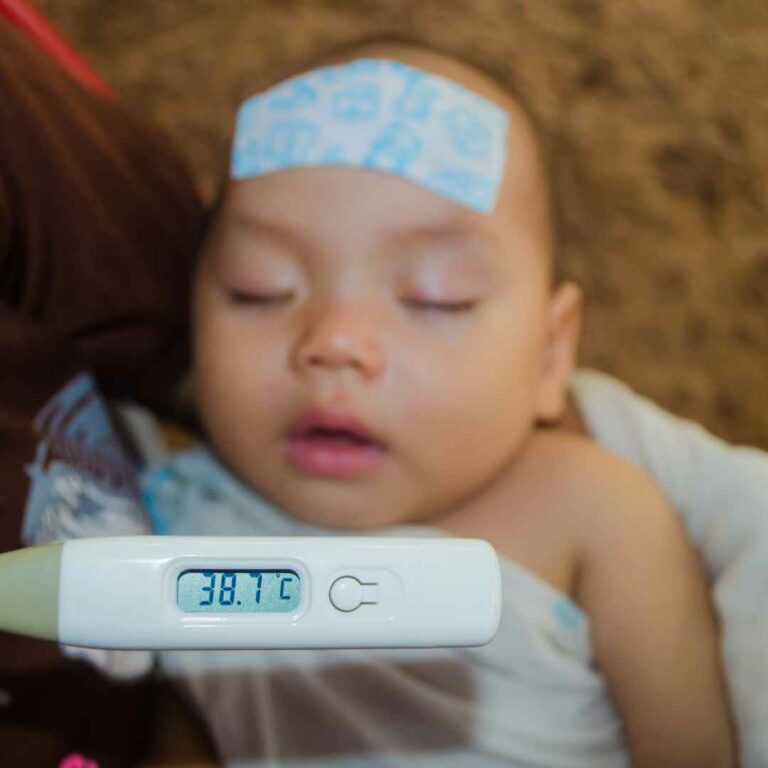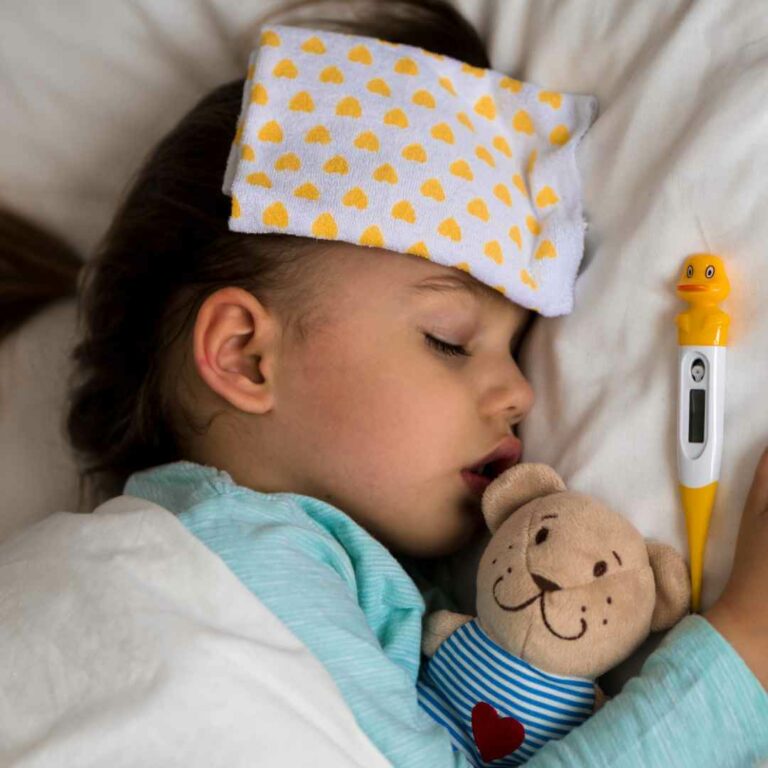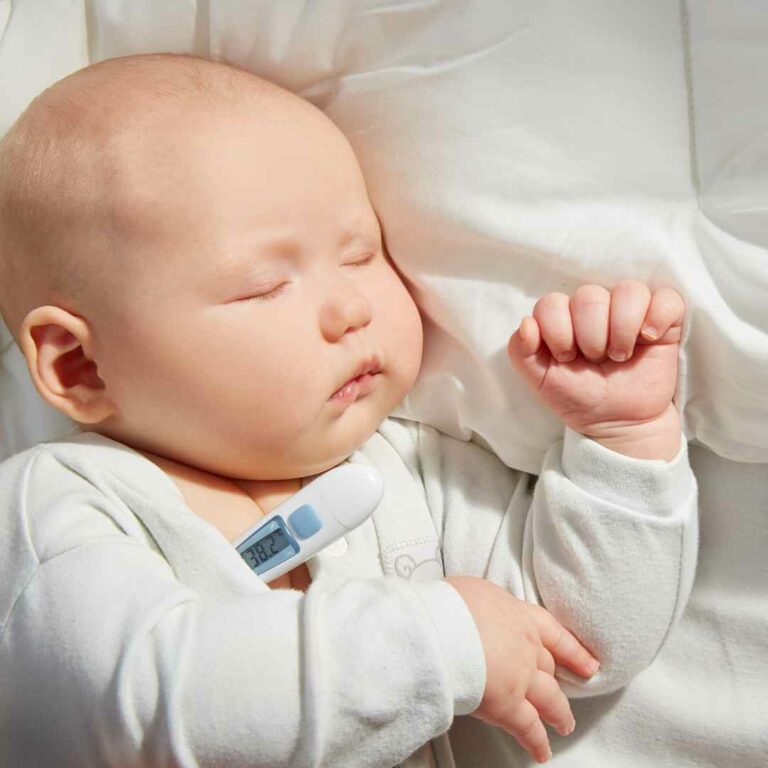Febrile Convulsions First Aid

Today we are going to talk about febrile convulsions and febrile convulsions first aid. It’s a relatively common part of childhood.
1 in 30 children suffer a febrile convulsion at some point between the age of 6 months and 6 years and it can be hereditary.
Today we will go through:
- What they are,
- What you can do
- Symptoms of a febrile convulsion
Febrile convulsion means hot (febrile) fit (convulsion). It happens when your child’s temperature shoots up, often out of nowhere, with no pre-warning and the child goes into a seizure because their body can’t cope with the temperature going up so high so quickly. It is all about the speed of the temperature rising.
As mentioned earlier, 1 child in 30 will have a febrile seizure at some point in their life.
You will learn about febrile convulsion first aid in most baby first aid courses
Although it looks like an epileptic seizure, it is actually not harmful to your child, however it looks very frightening.
Just remember that if your child suddenly has a seizure, it is highly unlikely to be an epileptic seizure because they are comparably rare in children, and it’s much more likely to be a febrile seizure.
Once your child has recovered, it is a good idea to take their temperature, once the seizure has stopped and your child is still and calm. This can be a vital piece of information for the emergency services.
When a child is brought to the emergency department with a febrile convulsion, we are less concerned about the convulsion than trying to figure out where that temperature is coming from. We want to find the source of the virus or infection.
Below are some of the signs and symptoms to look out for and pointers on what to do if your child has a febrile convulsion.

Signs and symptoms of a febrile convulsion:
- During the febrile convulsion, a child may lose consciousness, they’ll stiffen and jerk, they may go red or blue in the face.
- May last for several minutes.
- Once the convulsion stops, your child will regain consciousness, they might be sleepy and irritable afterwards.
- Your child may have a temperature
- They will often occur without the parent knowing there is anything wrong.
Febrile convulsions are normally very short lived, and the child is still breathing although they may change colour during the seizure
If there is a fever with convulsion?
Yes, this is what causes the seizure. Giving paracetamol and ibuprofen to your child will not stop a febrile convulsion.
First Aid for Febrile Convulsions
There is nothing you can do to make the convulsion stop, and you also shouldn’t try to stop it.
- Stay CALM.
- Remember if your child suddenly goes into a seizure, it is highly likely to be a febrile convulsion, that while it looks really scary, won’t hurt your child.
- Try to place your child on a soft surface. If they are having a convulsion on a hard floor, then instead of picking them up, get sofa cushions or blankets and bring them to your child and roll them onto them.
- Try and watch exactly what happens so you can relay it to the doctor.
- The official guidelines suggest taking pictures and/or videos
- Try to time exactly how long the convulsion lasts
- Don’t try to restrain your child, this could actually do more harm than good.
- Don’t put anything in their mouth, especially not your fingers
- Don’t put your child in a bath. This will not bring their temperature down. We have to remember that fever comes from the brain, telling the body to heat up, so cooling the skin down is not going to help at all.
- The first time your child has a febrile convulsion – call an ambulance – this will help make sure you get the right diagnosis. It might be that subsequent febrile convulsions do not need an ambulance, this will come from your confidence and education you receive from the emergency department.
- If you do not go to the emergency department, then present to your GP because you need to find out where the fever is coming from.
- If your child has had a febrile convulsion and they’ve come round and they seem alright, it might be okay to take them to the emergency department or the doctor in your car if there are two of you, because febrile convulsions usually don’t happen back to back.

Febrile Convulsions
Febrile convulsions are normally very short-lived, and your child will be breathing
When to call an ambulance:
- If it is your child’s first convulsion – always call an ambulance.
- If the convulsion is a subsequent convulsion and it lasts more than 5 minutes
- If your child does not wake up after they’ve had the convulsion
- If your child does not look well after the convulsion – trust your instinct and remember it is never wrong to call an ambulance.
Sometimes when children have long convulsions they might be watched in hospital for a while thereafter or overnight.
After a febrile convulsion, and after seeking medical advice, resume your normal routine, there is nothing special you need to do.
Remember that bed or cot is actually a very safe place for a child who may have a convulsion that we didn’t even know about. I am sure there’s been many children that have had convulsions in their beds or cots and we get to them afterwards when they cry out- so don’t be afraid to put them to bed.
Giving paracetamol and ibuprofen to your child will not stop a febrile convulsion
Your child may never experience a febrile convulsion, but it is really helpful to know what it is because it can be terrifying if you don’t know.
Want more? We’ve got you covered…
Our Baby First Aid Courses
Our baby first aid courses are available in person in your home and online. We run classes in your home with groups of 2, 4 or up to 10 in Sydney & Melbourne and you can book in 3 easy steps!
- Pick your class
- Follow the prompts to purchase
- We will contact you within 24 hours to lock in your date of choice
Our First Aid Certificate Courses
We run most of the popular first aid courses Australia wide. HLTAID011 Provide First Aid, HLTAID009 Provide CPR, HLTAID012 Provide First Aid in an Education & Care Setting, RAMOAP (anaphylaxis), Mental Health first aid and CPR/LVR to name a few.
Book your public spot online or contact us if you have a group of 5+ people for onsite training.
Here are some other resources you may enjoy!
FREE GUIDE: Your Virtual Baby First Aid Kit
FREE GUIDE: Introducing Common Allergy Foods & Allergic Reactions
FREE Workplace Emergency Preparedness Plan: Grab this at the bottom of every page!
Follow for baby & child first aid and allergy info and tips on Instagram, TikTok & Facebook all @thenestcpr
